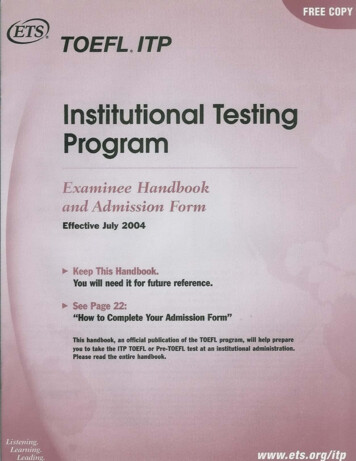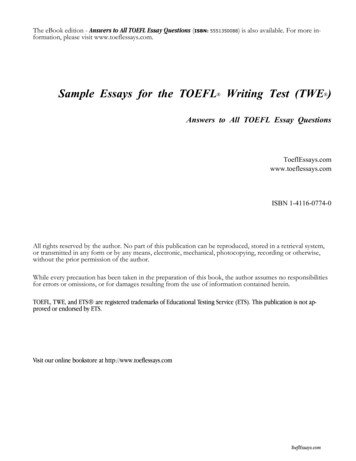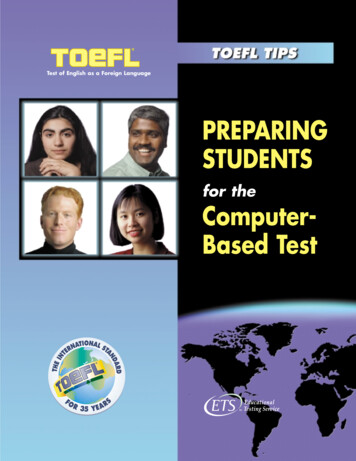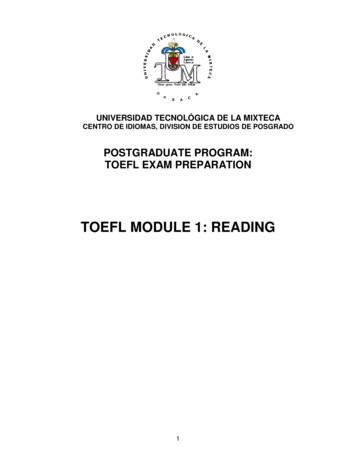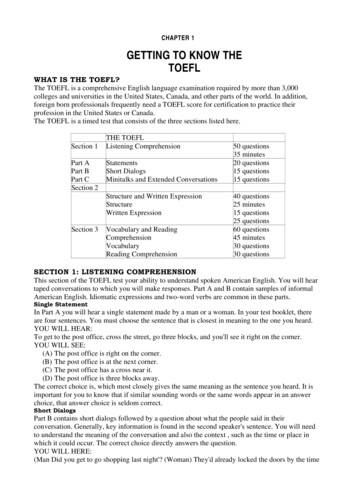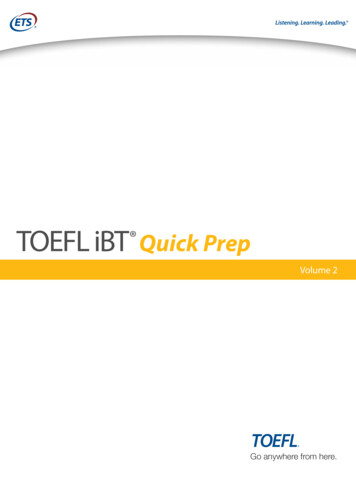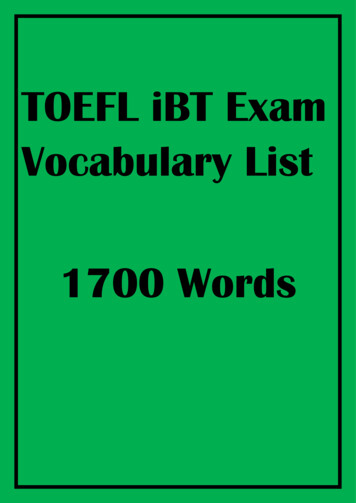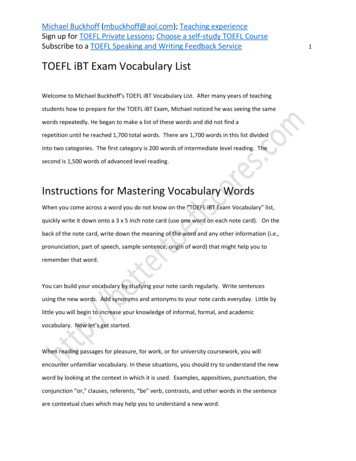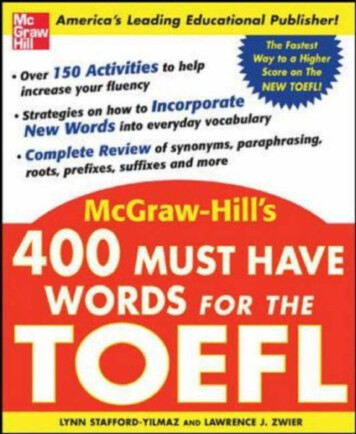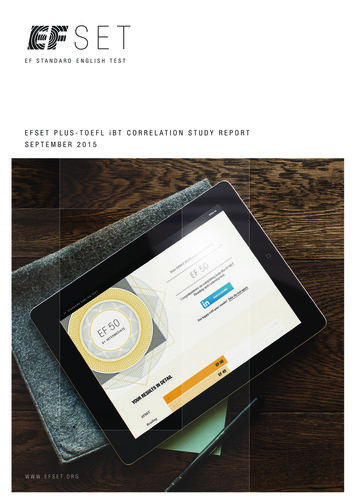
Transcription
W W W . E F S E T. O R G
EFSET PLUS-TOEFL CORRELATION STUDY REPORT 02
EXTERNAL VALIDITY OF EF SET PLUS WITH TOEFL iBTAbstractThis study was carried out to explore the statistical association between EF SET PLUSand TOEFL iBT scores. Three-hundred eighty four volunteer examinees participated inthe study. The results suggest moderately strong, positive correlations between EFSET PLUS and TOEFL for both the reading and listening scales and provide solidevidence of convergent validity. The reliabilities for both the EF SET PLUS reading andlistening score scales were also very high because of the adaptive nature of the test.EF SET PLUS-TOEFL CORRELATION STUDY REPORT 03
TABLE OF CONTENTSIntroduction5Analysis and Results12Discussion16References17About the Author18EF SET PLUS-TOEFL CORRELATION STUDY REPORT 04
INTRODUCTIONThis report describes a validation study carried out in fall 2014 for the new EFStandard English Test PLUS (EF SET PLUS). This report presents empirical, externalvalidity evidence regarding the relationship between EF SET PLUS proficiency scoresand reported Test of English as a Foreign Language (TOEFL iBT ) scores. The TOEFLiBT is an internet-based test of English language proficiency developed andadministered by Educational Testing Service. It is generally recognized as one of thepremier tests of English language proficiency in the world. The TOEFL iBT version wasreleased for operational use in 2005. Separate TOEFL component scores are reportedfor each of the four modalities (reading, listening, writing and speaking), each using ascore scale ranging from 0 to 30. The composite scale is a simple sum of thecomponent scores.In contrast, EF SET PLUS is a free, online test designed to provide separate measuresof English language reading and listening proficiency. The test is professionallydeveloped and administered online with a computer interface that is standardizedacross computer platforms. The reading and listening sections of EF SET PLUS areadaptively tailored to each examinee’s proficiency, providing an efficient and accurateway of assessing language skills. As an interpretive aid, performance scores on EFSET PLUS are directly aligned with six levels (A1 to C2) of the Council of Europe’sCommon European Framework of Reference (CEFR) for languages. For moreinformation, visit: www.efset.org/english-score/cefr.In this study, an international sample of non-native English language learners wasrecruited and screened over a period of months. Three-hundred eighty-four examineeswho met the study eligibility requirements were administered both EF SET PLUSreading and listening tests. As part of the eligibility requirements, the examineeswere required to upload a digital copy of their TOEFL iBT score report. Their scores onEF SET PLUS and their reported TOEFL listening and reading scores were thenanalyzed to investigate the degree of statistical correspondence between the tests. Thestudy results confirm that the EF SET PLUS scores are highly reliable across thecorresponding reading and listening score scales and maintain reasonable statisticalcorrespondence (convergent validity) with TOEFL reading and listening scores.This study found that EF SET PLUS scores correlated reasonably well with TOEFL iBTscores—somewhat better with the total TOEFL scores than with the separate readingand listening section scores. This provides fairly solid convergent validity evidence (seeCambell & Fiske, 1959), suggesting that the EF SET PLUS score scales are tappinginto some of the same English language skills as TOEFL.The next section of the paper describes the EF SET PLUS examinations and scoringprocess. It also describes the participant sample used for the validation study.Analysis and results are covered in the subsequent section.EF SET PLUS-TOEFL CORRELATION STUDY REPORT 0 5
INTRODUCTIONDescription of the EF SET PLUS Tests and Score ScalesSeparate reading and listening test forms which were statistically equivalent to the EFSET PLUS were used for this study. This was to ensure that there was no learningeffect of the publicly available EF SET PLUS. The EF SET tests employ various typesof selected-response item types, including multiple-selection items. A set of items isassociated with a specific reading or listening stimulus to comprise a task.In turn, one or more tasks are assembled as a unit to prescribed statistical and contentspecifications; these are called modules. The modules can vary in length, dependingon the number of items associated with each task. Because of the extra time neededto listen to the task-based aural stimuli, the listening modules tend to have slightlyfewer items than the reading modules. In general, the reading modules for this studyhad from 16 to 24 items. The listening modules each had between 12 and 18 items.In aggregate, each examinee was administered a three-stage test consisting of onemodule per stage.The actual test forms for EF SET and EF SET PLUS are administered using anadaptive framework known as computerized adaptive multistage testing or ca-MST(Luecht & Nungester, 1998; Luecht, 2000; Zenisky, Hambleton & Luecht, 2010; Luecht,2014a). Ca-MST is a psychometrically powerful and flexible test design that provideseach examinee with a test form customized for his or her demonstrated level oflanguage proficiency. For this study, each EF SET examinee was administered a threestage 1-3-4 ca-MST panel with three levels of difficulty at stage 2 and four levels ofdifficulty at stage 3 as shown in Figure 1. The panels are self-adapting. Once assignedto an examinee, each panel has internal routing instructions that create a statisticallyoptimal pathway for that examinee through the panel. The statistical optimization of therouting maximizes the precision of every examinee’s final score.As Figure 1 demonstrates, all examinees assigned a particular panel start withthe same module at Stage 1 (M1, a medium difficulty module). Based on theirperformance on the M1 module, they are then routed to either module E2, M2 or D2 atStage 2. The panel routes the lowest performing examinees to E2 and the highestperforming examinees to D2. All others are routed to M2. Combining performance fromboth Stages 1 and 2, each examinee is then routed to module VE3, ME3, MD3, or VD3for the final stage of testing. This type of adaptive routing has been demonstrated tosignificantly improve the precision of the final score estimates compared to a fixed(non-adaptive) test form of comparable length (Luecht & Nungester, 1998). The cutscores used for routing are established when the panel is constructed and statisticallyoptimize the precision of each pathway through the panel.EF SET PLUS-TOEFL CORRELATION STUDY REPORT 06
INTRODUCTIONStage 1Stage 2Stage 3HighLanguage ProficencyLowFigure1. An Example of a 1-3-4 ca-MST PanelAll EF SET items are statistically calibrated to the EF reading and listening score scales.The calibration process employs item response theory (IRT) to determine the difficulty ofeach item relative to all other items. The IRT-calibrated items and tasks for the readingand listening panels used in this study were previously administered to large samples ofEF examinees and calibrated using the Rasch calibration software program WINSTEPS(Linacre, 2014). This software is used world-wide for IRT calibrations. The IRT modelused for the calibrations is known as the partial-credit model or PCM (Wright & Masters,1982; Masters, 2010). The partial-credit model can be written as follows:xexp k 0 θ ( bi dik ) P ( x X θ;bi , di ) Pix ( θ ) m jexp k 0 θ ( bi dik ) j 0Equation 1where θ is the examinee’s proficiency score, bi denotes an item difficulty or location foritem i, and dik denotes two or more threshold parameters associated with separations ofthe category points for items that use three or more score points (k 0, ,xi). All readingitems and tasks for the EF Standard Setting (EF SET, 2104 - section 10) were calibratedto one IRT scale, θR. All listening items and tasks were calibrated to another IRT scale, θL.Using the calibrated PCM items and tasks, a language proficiency score on either the θRor θL scale can be readily estimated regardless of whether a particular examinee followsan easier or more difficult route through the panel (i.e. the routes or pathways denotedby the arrows in Figure 1). The differences in module difficulty within each panel areautomatically managed by a well-established IRT scoring process known as maximumlikelihood estimation (MLE).EF SET PLUS-TOEFL CORRELATION STUDY REPORT 07
INTRODUCTIONMLE scoring takes the various calibrated item difficulties along each panel routedirectly into account when estimating each examinee’s reading or listening score.As noted earlier, the EF score scales for reading and listening are aligned to theCouncil of Europe’s Common European Framework of Reference (CEFR) forlanguages. The CEFR provides a set of conceptual guidelines that describe theexpected proficiency of language learners at six levels, A1 to C2 (see Figure 2).Type ofLanguage UserLevelCodeDescriptionBeginnerA1Understands familiar everyday words, expressions andvery basic phrases aimed at the satisfaction of needs ofa concrete typeElementaryA2Understands sentences and frequently usedexpressions (e.g. personal and family information,shopping, local geography, employment)IntermediateB1Understand the main points of clear, standard input onfamiliar matters regularly encountered in work, school,leisure, etc.UpperIntermediateB2Understands main ideas of complex text or speech onboth concrete and abstract topics, including technicaldiscussions in field of specialisationAdvancedC1Understands a wide range of demanding, longer texts,and recognises implicit or nuanced meaningsC2Understands with ease virtually every form of materialread, including abstract or linguistically complex textsuch as manuals, specialised articles and literaryworks, and any kind of spoken language, including livebroadcasts delivered at native speedBasicIndependentProficientMasteryFigure 2. Six CEFR Language Proficiency Levels. Visit www.efset.org/english-score/cefr for more information.The content validity of the EF SET ca-MST modules and panels is well-establishedand follows state-of-the-art task and test design principles established by worldexperts on language and adaptive assessment design. The EF SET TechnicalBackground Report (EF SET, 2014) provides a comprehensive overview of the testdevelopment process. It should be noted that the EF SET and EF SET PLUSalignment to the CEFR levels was established through a formal standard-settingprocess (Luecht, 2014c; EF SET, 2014).EF SET PLUS-TOEFL CORRELATION STUDY REPORT 08
INTRODUCTIONValidation Study SampleExaminees were recruited to participate in the online EF validation study. The primaryeligibility requirements were: (a) having a valid email address and (b) being able toprovide by digital upload an official TOEFL iBT score report showing recent readingand listening scores. “Recent” was operationally defined as having taken the TOEFLiBT modules within the past 18 months. All potential examinees completed a briefsurvey to establish their eligibility and then uploaded a digital copy of their TOEFL iBTscore report. Only eligible candidates were allowed to proceed to the next phase andactually take the EF SET PLUS reading and listening forms. This validation studytesting was carried out during fall 2014.The examinees were administered and completed both an EFSET PLUS readingand listening panel. Every examinee that completed both EFSET PLUS panels withinthe testing window and whose performance demonstrated reasonable effort1 wascompensated with a voucher for 50. Ultimately, there were 384 participants withcomplete data2.Demographically, the sample was comprised of 197 (51.3%) women and 187(48.7%) men. Ages of the examinees ranged from 16 to 33 years; the average agewas 22.26 with a standard deviation of 1.95 years. Twenty-nine nationalities wererepresented in this study. The majority of the study participants (227 or 59.1%) listedtheir nationality as Brazilian. Other relatively high-percentage nationalities listed wereChina (11.5%), India (7.8%), and Germany (3.6%). The remaining participants werefrom other Asian countries, as well as various European, African and South Americannations. Education and English as a second language (ESL) experience of the sampleare jointly summarized in Table 1. In general, the sample was comprised primarily ofwell-educated, young Brazilian adults with somewhat extensive ESL experience. Thegender mix was about equal.1 Examinees who let entire modules blank or who otherwise exhibited an obvious lack of effort were excluded. The applicationprocess careully explained the study participation “rules” to each examinee.2 One examinee had taken the paper-and-pencil TOEFL, rather than the newer internet version. That individual was excludedfrom the study.EF SET PLUS-TOEFL CORRELATION STUDY REPORT 09
INTRODUCTIONTable 1. Language Experience and Educational Information for the Sample (N 384)Language ExperienceFrequencyPercentLess than 1 yr.1-3 years4-6 years7-9 yearsMore than 9 encyPercentDid not finish high/secondary schoolHigh/secondary schoolFurther education: some collegeBachelor’s degreeMaster’s degreeOther r Area of StudyFrequencyPercentSciencesBusinessArt and designMathematicsSocial SciencesLanguagesHumanitiesPoliticsElectrical engineeringGeoinformatic 3.9%1.3%0.8%0.3%0.3%0.3%Missing or other9224.0%EF SET PLUS-TOEFL CORRELATION STUDY REPORT 10
INTRODUCTIONTOEFL iBT scores for the 384 participants are summarized in Table 2. Note thatone examinee was missing a valid TOEFL reading score; another was missing avalid TOEFL listening score. Therefore, the counts for the TOEFL components areonly NR NL 383. On average, the participants in this study would be classified ashaving “high” TOEFL reading and listening proficiency3, although the ranges of scoresdefinitely cover reasonable spreads of English language knowledge and skill.Table 2. Summary of TOEFL PerformanceStatisticsReported TOEFL 23.06589.964Std. The EF SET PLUS descriptive statistics on the key proficiency-related variables,estimated reliability coefficients, correlations (observed and disattentuated), andsome auxiliary performance comparisons between the validation study participants’EF SET PLUS listening and reading scores and TOEFL iBT scores are presented inthe next section.3Based on interpretive inormation published by ETS EF SET PLUS-TOEFL CORRELATION STUDY REPORT 11
ANALYSIS AND RESULTSDescriptive statistics for the EF SET PLUS scores are shown in Table 3 for the 384examinees that participated in this study. The variables “Reading θR“ and “Listening θL“are the two EF SET PLUS proficiency scores. By IRT convention, proficiency scoresestimates are often denoted by the Greek letter θ (“theta”). Note that in practice, theseIRT scores are rescaled to a more convenient and somewhat more interpretable set ofscale values (0 to 100). For various technical statistical reasons, that rescaling was notapplied for purposes of this study. Here, it is sufficient to note that the score estimatesof θR and θL can be negative or positive4, where higher positive numbers denote betterlanguage proficiency as measured by the EF SET PLUS ca-MST panels.Because of the adaptive multistage test design used for EF SET PLUS, the reliabilitiesof the EF SET PLUS reading and listening scores are excellent and provide accuratemeasures across the scales.Table 3. EF SET PPLUS Descriptive Statistics for EF SET PLUS IRT ProficiencyScores (N 384)StatisticsReading θRListening θLMean0.8671.308Std. 3.204As suggested by Table 2 (shown earlier), the sample appeared to be highly proficientin English on average. Table 3 again confirms that finding. Consider that the EF SETPLUS means and standard deviations for extremely large samples of more than37,000 examinees were, respectively, -0.10 and 1.09 for reading and -0.16 and 1.14for listening. The implication is that, compared to those very large sample statistics,these 384 study participants were, on average, at the 81st percentile for reading andat the 90th percentile for listening5.45The IRT calibration software, WINSTEPS (Linacre, 2014) scales the EF SET PLUS item banks to have a mean item difficultyparameter estimates (scale locations centersozero. The examinees’ scores are not centered or otherwise standardized to zeroand should not be interpreted as “z-scores” or other normal-curve equivalents.These comparative results are based on normal approximation percentiles, using the large-sample means and standard deviationsas reasonable estimates of the population distributional parameters.EF SET PLUS-TOEFL CORRELATION STUDY REPORT 12
ANALYSIS AND RESULTSAn important benefit of the multistage test design used for EF SET PLUS is evident whenconsidering the impact on score accuracy or reliability. The adaptive EF SET PLUS panels(see Figure 1) are specifically designed to provide somewhat more uniform precisionACROSS entire the score scale—providing the best possible precision of the estimatesof θR and θL. It is common to report a score reliability coefficient as an omnibus index ofscore accuracy—one of the most commonly reported types of reliability coefficient iscalled Cronbach’s α (“alpha”,). Cronbach’s α provides a somewhat conservative estimateof the average consistency of scores across the scale (Haertel, 2006). Values above 0.9are considered to be very good. Because of the adaptive nature of the EF SET PLUSpanels, traditional reliability coefficients can only be approximated using what is termed amarginal reliability coefficient. This type of reliability of coefficient is computed asE σ2ρ2 ˆθ , θ 1 2σ( )(ˆθ θ) (ˆθ)Equation 2where the numerator of the rightmost term is the average error variance of estimate forthe IRT proficiency scores and the denominator of the rightmost term is the varianceof the estimated IRT θ scores (Lord & Novick, 1968). Provided that the data fit the IRTmodel used for calibration and scoring—the PCM in the case of EF SET PLUS—thismarginal reliability is usually very comparable to Cronbach’s α coefficient. The marginalreliability coefficients for EF SET PLUS are 0.949 for reading and 0.944 for listening, basedon samples of more than 37,000 examinees. This implies excellent reliability across thescore scale—a direct and entirely expected outcome of using an adaptive multistagetesting design. The reliability coefficients are used to adjust the correlations between EFSET PLUS and TOEFL, as discussed below.Pairwise Pearson product-moment correlations were computed between five scorevariables: (i) TOEFL iBT reading scores; (ii) TOEFL iBT listening scores; (iii) TOEFL iBT totalscores; (iv) EF SET PLUS IRT score estimates for θR (reading); and (iv) EF SET PLUS scoreestimates of θL for listening. Correlations denote the degree of statistical linear associationbetween pairs of variables. Values near 1.0 indicate an almost perfect linear relationshipbetween the variable pair. Values near zero indicate almost no linear association andvalues near 1.0 indicate a nearly perfect inverse relationship (i.e. increasing values onone variable are strongly associated with decreasing values on the second variable).Validity studies such as this often result in “moderate”, positive correlations (e.g. 0.4 to0.7). The product-moment correlations between the observed TOEFL and EF SET PLUSscores are shown in the lower “triangle” of the correlation matrix in Table 4 (i.e. in theunshaded cells below the diagonal of the matrix). There is one correlation for each pairingof the five variables.EF SET PLUS-TOEFL CORRELATION STUDY REPORT 13
ANALYSIS AND RESULTSTOEFL iBT ScoresEFSET PLUS ScoresReadingListeningTotalθRθLTOEFL Reading0.850.890.980.700.65TOEFL Listening0.750.851.000.660.77TOEFL IBT Total0.880.900.940.660.68EF SET PLUS Reading θR0.630.600.630.950.76EFS ET PLUS Reading θL0.580.690.640.720.94Score VariablesTable 4. Correlations Between TOEFL and EF SET PLUS Scores(Disattenuated Correlations Above the Diagonal, Reliability Coefficients on the Diagonal othe MatrixThe correlations in the upper (shaded) section of the matrix in Table 4 are calleddisattentuated correlations. That is, they estimate the statistical relationships between thefive scores if measurement or score estimation errors were eliminated all-together. Thedisattenuated correlations are computed by dividing each observed product-momentcorrelation by the square root of the product of the reliability coefficients for each scoreincluded in the pairing (Haertel, 2006, p. 85). Because the reliability coefficients for theTOELF iBT and EF SET PLUS scores are all relatively high, the magnitude of increasein the true-score [disattentuated] correlations is not much larger than the observedcorrelations in the lower section of the matrix. It should be further apparent that the EFSET PLUS reading and listening scores are at a comparable level of reliability tothe total (composite) TOEFL iBT scores. The most relevant correlations from a validityperspective are the two disattentuated correlations between the TOEFL iBT reading andestimated EF SET PLUS θR scores (0.70) and between the TOEFL listening and estimatedEF SET PLUS θL scores (0.77). Those correlations suggest a fairly strong, positive linearassociation between the TOEFL iBT and EF SET PLUS scores.Figures 3 and 4 respectively show the scatter plots for the observed reading and listeningscores. The TOEFL iBT scores are plotted relative to the horizontal axis in each plot. TheEF SET PLUS scores are plotted relative to the vertical axis. The best-fitting regressionline is also shown for each pair of score variables. It should be apparent that the EF SETPLUS scores are somewhat more variable than the reported TOEFL iBT scores.EF SET PLUS-TOEFL CORRELATION STUDY REPORT 14
ANALYSIS AND RESULTS4EF SETReadingScores,θR3210- ‐1- ‐25101520TOEFLiBTReadingScores2530Figure 3. Scatterplot of EF SET PLUS (Vertical) by TOEFL iBT Reading Scores4EF SETListeningScores,θL3210- ‐1- ‐25101520TOEFLiBTListeningScores2530Figure 4. Scatterplot of EF SET PLUS (Vertical) by TOEFL iBT Reading ScoresIt would not be realistic to expect perfect correspondence between EF SET PLUSand TOEFL scores. The tests are different but appear to measure some of thesame composites of English reading and listening skills. The fact that there are onlymoderately high, positive, disattentuated correlations between TOEFL and EF SETPLUS scores may be due to a plethora of factors ranging from some restriction of thevariation in the scores due to study eligibility requirements to the scaling and roundingof the TOEFL section scores to integer values ranging from 0 to 30. Or, the EF SETPLUS tasks and scales may simply be getting a slightly different constellation of Englishlanguage traits. In any case, these results provide fairly solid convergent validityevidence.EF SET PLUS-TOEFL CORRELATION STUDY REPORT 15
DISCUSSIONthat measure similar—but not necessarily the same—constructs. An example would be the well-known concordance betweencollege admissions tests like the ACT Assessment (Act, Inc.and the Scholastic Aptitude Test (SATin the US. Basing concordanceon tests with only moderate correlations can lead to misuse othe scores isome users consider the scores to actually beexchangeable. Concorded scores are not exchangeable (Kolen & Brennan, 2014). A policy decision was therefore made NOTto provide concordance information between TOEFL and EF SE T PLUS until additional evidence is gathered.EF SET PLUS-TOEFL CORRELATION STUDY REPORT 16
REFERENCESAmerican Educational Research Association, American Psychological Association,National Council on Measurement in Education. (2014). Standards for Educational andPsychological Testing. Washington, DC: AERA.Campell, D. T, & Fiske, D. W. (1959). Convergent and discriminant validation by themultitrait-multimethod matrix. Psychological Bulletin, 56, 81-105Educational Testing Service. (2011). Reliability and comparability of TOEFL iBT scores. TOEFL iBT Research Insight, Series I, Volume 3. Princeton, NJ: Author.EF. (2014). EF SET Technical Background Report. London, U.K: www.efset.org.Haertel, E. H. (2006). Reliability. In R. L. Brennan (Ed.).Educational Measurement, 4th Edition, pp. 65-110.Washington, DC: American Council on Education/Praeger Publishers.International English Language Testing System. (2013).IELTS Researchers - Test performance 2013.Author: International English Language Testing System, www.ielts.org.International Test Commission. (2008). International Test Commission Guidelines.Website: www.intestcom.org/guidelines/Kolen, M. J. & Brennan, R. L. (2014). Test equating, scaling, and linking: Methods andpractices, 2nd edition. New York: Springer.Linacre, M. (2014). WINSTEPS Rasch Measurement (Version 3.81).[Computer program]. Author: www.winsteps.com.Lord F.M. & Novick, M. (1968). Statistical theories of mental test scores.Reading, MA: Addison-Wesley.Luecht, R. M. (2000, April). Implementing the computer-adaptive sequential testing(CAST) framework to mass produce high quality computer-adaptive and masterytests. Symposium paper presented at the Annual Meeting of the National Council onMeasurement in Education, New Orleans, LA.Luecht, R. M. (2014a). External validity and reliability of EF SET .[EF technical report]. London, U.K.: EF.Luecht, R. M. (2014b). Computerized adaptive multistage design considerationsand operational issues (pp. 69-83). In D. Yan, A. A. von Davier & C. Lewis (Eds.)Computerized Multistage Testing: Theory and Applications. New York: Taylor-Francis.EF SET PLUS-TOEFL CORRELATION STUDY REPORT 17
ABOUT THE AUTHORRichard M. Luecht, PhD, Professor of Educational Research Methodology at theUniversity of North Carolina at Greensboro (UNCG), is the chief psychometricconsultant for the EF SET team. He is also a Senior Research Scientist with the Centerfor Assessment Research and Technology, a not-for-profit psychometric servicesdivision of the Center for Credentialing and Education, Greensboro, NC.Ric has published numerous articles and book chapters on technical measurementissues. He has been a technical consultant and advisor for many state department ofeducation testing agencies and large-scale testing organizations, including New York,Pennsylvania, Delaware, Georgia, North Carolina, South Carolina, New Jersey, PuertoRico, The College Board, Educational Testing Service, HUMRRO, the Partnership forAssessment of Readiness for College and Career (PARCC), the National Center andState Collaborative (NCSC), the American Institute of Certified Public Accountants, theNational Board on Professional Teaching Standards, Cisco Corporation, the DefenseLanguage Institute, the National Commission on the Certification of PhysiciansAssistants, and Education First (EF SET).He has been an active participant previously at the National Council of Measurementin Education (NCME), American Educational Research Association (AERA) andAssociation of Test Publishers (ATP)meetings, teaching workshops and givingpresentations on topics such as assessment engineering and principled assessmentdesign, computer-based testing, multistage testing design and implementation,standard setting, automated test assembly, IRT calibration, scale maintenanceand scoring, designing complex performance assessments, diagnostic testing,multidimensional IRT, and language testing.Before joining UNCG, Ric was the Director for Computerized Adaptive TestingResearch and Senior Psychometrician at the National Board of Medical Examinerswhere he oversaw psychometric processing for the United States Medical LicensingExamination (USMLE) Step and numerous subject examinations, as well beinginstrumental in the design of systems and technologies for the migration of the UnitedStates Medical Licensing Examination programs to computerized delivery. He hasalso designed software systems and algorithms for large-scale automated testassembly and devised a computerized adaptive multistage testing implementationframework that is used by a number of large-scale testing programs. His most recentwork involves the development of a comprehensive framework and associatedmethodologies for a new approach to large-scale formative assessment design andimplementation called assessment engineering (AE).EF SET PLUS-TOEFL CORRELATION STUDY REPORT 18
WWW.EFSET.ORGCopyright EF Education First Ltd. All rights reserved
The TOEFL iBT is an internet-based test of English language proficiency developed and administered by Educational Testing Service. It is generally recognized as one of the premier tests of English language proficiency in the world. The TOEFL iBT version was released for operational use in 2005. Sepa
